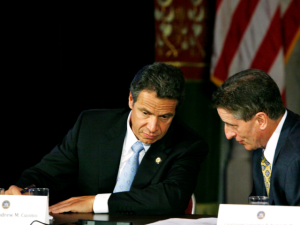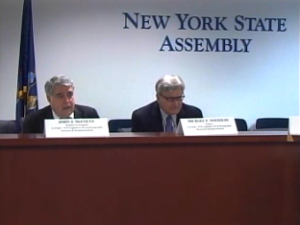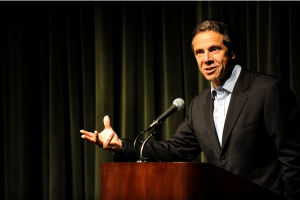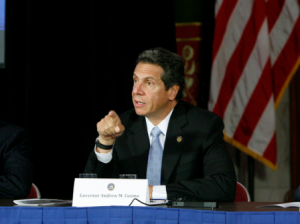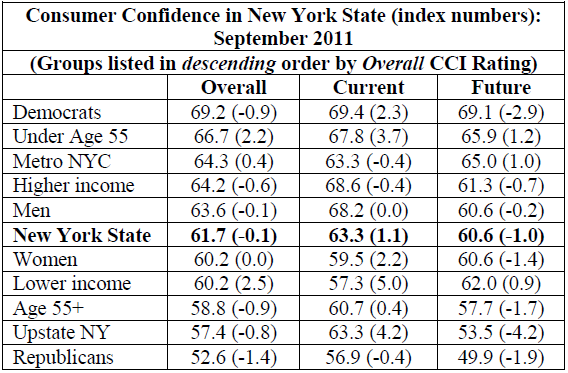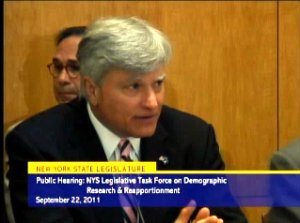Colby Hamilton appears in the following:
Quinn continues to lead 2013 Democratic field
Wednesday, October 19, 2011
Wanted to just break this out from the rest of the Quinnipiac results:
Regardless of who else is running, City Council Speaker Christine Quinn continues to lead all other rivals with Democratic voters. Among all voters, when added to the equation, Police Commissioner Ray Kelly remains at the top of the heap.
At this point, though, the 2013 polls remain mostly a name recognition game:
- Police Commissioner Ray Kelly -- 25 percent, with 17 percent of Democrats;
- City Council Speaker Christine Quinn – 17 percent, with 22 percent of Democrats;
- Brooklyn Borough President Marty Markowitz – 14 percent, with 15 percent of Democrats;
- City Comptroller John Liu – 10 percent, with 10 percent of Democrats;
- Former City Comptroller William Thompson – 8 percent, with 9 percent of Democrats;
- Public Advocate Bill de Blasio – 6 percent, with 7 percent of Democrats;
- Manhattan Borough President Scott Stringer – 5 percent, with 6 percent of Democrats
USS Bloomberg adrift in third term say NY voters
Wednesday, October 19, 2011
More than half of respondents in a new Quinnipiac poll say Mayor Bloomberg has lost focus during his third term, which the mayor was able to serve thanks to a controversial overturn of city law. According to the poll, 52 percent of New York City voters polled said the mayor was adrift.
Likewise, the bump in job approval number the mayor received after the tropical storm scare earlier this summer has been erased. The mayor's post-storm job approval high was 52 percent on September 12. It's now fallen back back to near the 45 percent mark it was at on July 27, according to Quinnipiac.
Quinn: We have to respond to loss of hope felt by protesters
Tuesday, October 18, 2011
Council Speaker Quinn, right, with members of the DUMBO BID (Courtesy of the NYC Council / William Alatriste)
City Council Speaker Christine Quinn stopped by WNYC’s Brian Lehrer Show to talk about, among other things, the city’s economy. She had addressed the Association for a Better New York before coming on the show on the issue.
But listening to it, Quinn also sounded a lot like a candidate trying to provide a vision for the city she hopes to run. The big vision discussion tied Quinn’s view of how the city should help support job growth to Occupy Wall Street.
“The larger, more important issue is a loss of hope,” Quinn said, explaining the core of what she believes is driving the protestors.
She went on to say that hope, which had been fueled by the belief in the American Dream, was in danger. “People are worried, really on all sides of the political spectrum, that that is slipping away.”
Her solution: “[T]o do what we can to create employment opportunities at all different levels of the education and economic spectrum.”
The current mayor couldn’t have said it better himself. Her focus on bolstering technology growth in the city, through new educational opportunities and in fields once thought the domain of Silicon Valley, sounds like the blueprint Mayor Bloomberg has been following for years. “We have to work hard to make New York City the tech capital of the world,” Quinn said, sounding remarkably Bloombergian.
Occupy Wall Street: Killing it in the polls
Tuesday, October 18, 2011
While the media debates exactly what the month-long protest in Zuccotti Park in downtown Manhattan means, voters throughout New York have made it clear they support Occupy Wall Street.
A new poll released this morning by Siena Research Institute follows up on a poll yesterday from Quinnipiac with similar results. In the Siena poll, 58 percent of respondents said the protesters "represent the 99 percent of people that will no longer tolerate the greed and corruption of the remaining one percent."
The Quinnipiac results were even more favorable: fully two-thirds of those polled said they agreed with the views of the Wall Street protesters.
Interestingly, in both polls, even as a majority of self-declared Republicans disagree with the views of the protesters, at least 30 percent in each poll have a favorable view or agree with them.
PEF executive board approves new deal
Monday, October 17, 2011
Let's try this one more time.
After announcing earlier that a deal had been reached between PEF officials and Governor Cuomo's office, the union's executive board approved the new contract. Now, it's back to the membership who recently rejected the first version of a new contract.
“The Executive Board recognizes the changes we were able to obtain under the revised agreement address many of the concerns of our members,” PEF President Ken Brynien said in a statement. “Today’s vote gives hope to the 3,496 members who face losing their jobs if the contract is not approved. The revised agreement balances the needs of all of our members and I am strongly encouraging our membership to ratify the new agreement to save the jobs of their co-workers while preserving the level of service to taxpayers."
The membership has until November 3 to make its decision.
Latino redistricting efforts through the lens of a (Latino-less) mayoral field
Monday, October 17, 2011
We've been talking a lot about the redistricting process, and, specifically, how community activists are pushing for more racial and ethnic "majority minority" state legislative seats (and maybe even Federal).
Looking through that lens at City Hall's Laura Nahmias's piece on the dearth of Latino contenders in 2013, and you can see another reason advocates will cite in their case for giving Latinos communities more weight in more districts. As Laura's source says:
“The ‘wait your turn’ game of Democratic politics hurts the community’s possibility of growth in Latino leadership,” said political commentator Gerson Borrero, who said the city hadn’t had a reputable candidate since Fernando Ferrer won the Democratic primary for mayor in 2005.
But, of course, an increase of downstate Latino members of the Senate and Assembly doesn't necessarily mean more Latino mayoral candidates--or even a Latino mayor. But, as the proponents for more Latino majority districts point out, providing Latino communities with more outlets could be a shot in the arm to the city's undersized Latino political community.
That being said, this might be the most telling paragraph of the piece and a strategy that continues to cut against the race-based policies of yore:
Some Latino politicians said that while representation was crucial, the city would benefit from any minority or strong progressive Democrat winning in citywide office. Candidates such as Comptroller John Liu and Councilwoman Letitia James, who are seen as potential candidates for mayor and public advocate, respectively, share political positions with some Latino politicians on issues like immigration or poverty.
That being said, as specifically Asian and Latino groups push for more political representation, it's worth examining the politics behind this sort of rainbow coalition strategy.
Ward vs Bloomberg on key Brooklyn waterfront development issues
Monday, October 17, 2011
WNYC's Jim O'Grady caught up with the outgoing head of Port Authority last week. Ward delivered a keynote speech on the sorry state of the city's infrastructure, and had this to say about some key portions of the city's waterfront:
I will state here today, as the outgoing director of the Port Authority, that Governor’s Island will never realize its full economic potential so long as the Red Hook Container Terminal remains a container terminal.
What makes this worth pointing out is how at odds this statement is with the city's own plans for the waterfront. Earlier this year the Bloomberg administration, the Economic Development Corporation and City Planning put together a set of plans for the city's waterfront. In the action plan, it states:
- Red Hook: Provide additional berthing locations to commercial vessels along the north side of Atlantic Basin. (EDC, 2011)
- Red Hook: Market the Container Terminal as a distribution hub for containerized cargo destined for East of Hudson businesses.
(EDC, 2011)
The city is also investing heavily in Sunset Park waterfront business development, which includes the expansion of shipping facilities there. Ward and Bloomberg have been at odds before on projects--i.e. World Trade Center--so it's interesting to see the differences between the infrastructure-minded Ward and the development-focused Bloomberg administration on a key issue.
Cuomo, PEF reach tentative agreement
Monday, October 17, 2011
Governor Cuomo, left, with Lt. Governor Duffy (Courtesy of the Governor's office)
The Public Employees Federation's leadership and Governor Andrew Cuomo's office both announced over the weekend that they'd come to a tentative agreement to avoid layoffs--something 70 percent of New Yorkers support, according to a new Siena Research Institute Poll.
The new four-year (versus original five-year) contract would still freeze raises for three years, and would change how furlough days are reimbursed at the end of the contract.
“The changes we were able to obtain under this revised agreement address many of the concerns raised by our members," PEF President Ken Brynien said in a statement.
“If the agreement is approved by our executive board and ratified by the full membership the jobs of 3,496 members will be saved."
"The Administration has worked very hard with the PEF leadership to make modifications which the leadership believes will address the concerns of the membership." Governor Cuomo said in his own statement. He went on to not that the new contract hadn't changed the math on the state's side--"contract modifications are revenue neutral to the state"--nor the language that would allow the governor to enact layoffs in the future.
"I am confident that my Administration has been more than reasonable and fair, as CSEA's ratification demonstrates. Simply put, the fate of the members is in the union's hands. It's up to them," the governor said.
This should make the 70 percent of New Yorkers who wanted the governor to go back to the negotiating table happy, according to a new Siena Research Institute poll.
“While a plurality of voters would like to see state workforce cuts if spending reductions are used to close next year’s state budget deficit, right now, the vast majority of voters do not want to see 3,500 state employees being handed their pink slips,” Siena College pollster Steven Greenberg said in a statement. “Advice to gov: keep speaking and hold back on the stick.”
Queens to add Indian language(s) to election material--but which?
Friday, October 14, 2011
This came over the wire a few days ago. It looks like the population of people from the Indian subcontinent has past the five percent threshold in Queens, which, by Federal law, means the Board of Elections needs to provide that population with materials in their language.
Of course, there are (at least) 144 different dialects in India. The big four that are under consideration, according to conversations with the Census and Sarah Steiner, an election lawyer and former Queens Assistant DA, are:
- Hindi
- Urdu
- Gujarati
- Pashto
- There's also a possibility of Bengali being included
The Department of Justice is actually responsible for working with local election officials to decide where, specifically, the languages need to be available, how election officials will make the languages available (interpreters, printed on ballots, etc.), as well as which languages will actually be used.
"The Department of Justice has not yet figured out what it's going to do," Steiner said.
Officials from the Census Bureau, as well as the New York City Board of Elections, were unavailable for comment at this time. When they get back to me, I'll post any updates.
The battle over local fracking bans begins in Dryden, NY
Friday, October 14, 2011
By Matt Richmond/WSKG of Innovation Trail
There's a showdown brewing in Dryden, New York.
Back in August, the town passed a zoning ordinance that banned the practice of hydrofracking for natural gas. A month later, they were being sued by gas company Anschutz Exploration.
What happens here - who flinches, who wins - will reverberate across the rest of New York state. And it all hinges on a simple question:
Can you, or can't you, ban drilling within your own town limits?
"Incompatible with our lifestyle"
Town officials in Dryden and across New York started preparing for gas drillingyears ago, when they began to see more and more leasing activity, says Dryden's supervisor Mary Ann Sumner.
"Somewhere in this process we realized ... that the gas industry was a heavy industrial use that is simply incompatible with our lifestyle," she says.
So Dryden attacked the issue on two fronts. First, it tried to work with the state to lessen drilling's impacts.
Environmental Conservation Law (ECL) 2303 gives the state sole power to regulate gas companies. That law, passed in the 1970s, would probably be much more contentious if it were to come to the state legislature today, says University of Albany Professor Erica Powers.
"Like many laws, that amendment to the constitution was proposed by the industry," says Powers.
Sumner says at the outset Dryden made an effort to comply with that law. They tried to collaborate with the state Department of Environmental Conservation (DEC) on Anschutz Exploration’s application to drill locally.
But town officials noticed some problems with Anschutz's application - it had ignored the presence of a stream and power transmission lines - and ended up feeling like they couldn’t trust the DEC to protect them.
So Dryden applied its second tactic: it classified drilling as "heavy industry," prohibiting it under the town's zoning law. And that triggered the lawsuit that Dryden is facing today.
Nozzolio defends progress on prisoner placement, Jeffries says Senate majority is 'stonewalling'
Thursday, October 13, 2011
Assemblyman McEneny, left, and Senator Nozzolio, right (Courtesy of the LATFOR Committee.)
I caught up with Senator Michael Nozzolio yesterday, after I hadpublished my piece on LATFOR’s progress with prisoner reallocation. Nozzolio is, of course, the co-chair of the committee, and the Senate Republican Majority’s representative. In the piece I wrote about the Democratically-controlled Assembly’s work to follow the current law that would count predominately upstate prisoners back in the predominately downstate communities for the purposes of redistricting.
Senator Nozzolio sent a letter to LATFOR at the end of last month instructing it to “immediately begin geocoding” the prisoner data. This, understandable, struck some on the Assembly side as odd, considering they’d already done the work and submitted it to LATFOR. Nozzolio made no mention of their work in his letter. He did, however, acknowledge receiving it when asked yesterday, saying the Assembly work deserved “great praise.”
“They did a terrific job,” Nozzolio said before making a clarifying statement: “They [the LATFOR staff] had a responsibility to just not accept [what the Assembly submitted] at total face value without scrutinizing the information.”
Currently, the senator said, LATFOR’s staff of cartographers and “census professionals” are analyzing what the Assembly staff did to see if it passes muster. So far, Nozzolio said, things were looking good.
MTA head search exposes Cuomo's first priority in hires: himself
Thursday, October 13, 2011
Our sister site Transportation Nation followed up on reports that the search to replace Jay Walder as head of the MTA may be soon over. Former Giuliani aide Joseph Lhota is said to be leading the pack as a possible candidate.
If Lhota was picked, Governor Cuomo would be replacing a transit professional with a manger with experience handling government. He'd also be putting a former Republican operative into the driver seat of the often vilified agency Republicans from around the state are working to strip of revenue via the payroll tax they say is crippling local economies and fundamentally unfair.
From the Transportation Nation piece:
The precipice on which the NY MTA teeters consists of several difficulties: a 2012-2015 capital construction plan with a $10 billion dollar shortfall; a looming contract negotiation with Transport Workers Union Local 100 that, by all signs, will be acrimonious; a threat from a group of state legislators to cut the dedicated revenue stream that is the regional payroll mobility tax, which last year contributed $1.3 billion to authority coffers. That’s about an eighth of the authority’s operating budget.
Sources differed on Lhota’s ability to rise to those challenges. The NY MTA needs someone “who can handle the union relationships, the crisis of money, and Lhota will get it faster than most people,” said one. Another thought the Republican Lhota could help the Democrat Cuomo beat back a Republican-led push in the state legislature to eliminate the payroll mobility tax.
But a third believed Lhota was the front-runner precisely because he won’t speak up too loudly for the needs of mass transit: “He’s going to be the person who makes the cuts without making any demands on the state budget. He may even then turn around and say to the city, ‘It’s all your fault.’ He’s going to protect Andrew Cuomo from the hard choices.”
The replacement process, and the potential Lhota pick, is illuminating a tendency in the Cuomo administration. The search committee members signed confidentiality agreements--not unusual by themselves. What was interesting was how tight-lipped everyone actually was. The fact this information was leaked even led some people close to the process to wonder if it wasn't a Cuomo-controlled event meant to test public reaction to Lhota's candidacy.
If things are as they are shaping up to be, and Lhota is the front runner, the third quoted paragraph is the most interesting. In, at best, creating a hostile environment for Walder, the Cuomo administration made a decision to alienate a transit lifer liked by both elected officials and transit advocates.
A Lhota appointment look based on political calculations more than anything else. The Cuomo people are signaling an interest in reducing their exposure to potential political problems, not in solving the agency’s unsustainable financial crisis. This of course was created over the years by politicians worried about their political exposure.
If you add in the push-out of Chris Ward at the Port Authority, it's Cuomo's top priority is having his people in key, highly-public posts who will put the governor’s political interests first.
But who does that serve, if political decisions are put ahead of qualification or competency, other than Cuomo's public image and political leverage? It's a question that will continue to be asked if Lhota ends up at the top of the MTA pile.
Is a 40 percent Asian Congressional district in Queens possible?
Thursday, October 13, 2011
One of the main issues being discussed during redistricting is providing communities of interest--often meaning, in short hand, racial and ethnic groups--with political boundaries that give these under-served groups greater influence over who represents them.
Last week a coalition of social justice groups released draft maps for the state legislature seats here in the city. Asian and Latino-majority districts were carved out for both the Assembly and State Senate, while existing African American districts were kept intact. Today Common Cause, who has been pushing this issue, has an op-ed in El Diario on the need for more majority Latino districts.
"Where the lines are drawn have the power to influence whether a particular neighborhood or community will be able to elect the representative of their choice," Susan Lerner, the group's executive director, wrote in the English version. "Communities that are divided among several districts – as neighborhoods with large numbers of Latinos have been in current and previous district maps - find it harder to gather the voting strength to make a difference at the polls."
At the Congressional level there have been pushes to create both a Latino--predominately Dominican--Congressional district in Northern Manhattan and the Bronx. There has also been speculation that a 40 percent Asian district could be created in Queens.
We decided to see if that was possible. John Keefe, our map wizard at WNYC, dug through census data to carve out what would be a 40.3 percent Asian district.
A few things. First, race can't be the only thing used to create a political map, per Federal rules. This was the specific thing we were looking to do, and did our best to keep the district as condensed as possible. Still, as you can see, it's not the most visually pleasing map. Other groups working on maps they plan to submit to LATFOR, the legislative group drawing the lines, say it's possible to create a 40 percent Asian district that is more tightly constructed.
But what the map does illustrate is that it's possible to create such a district. More importantly, the Asian community in Queens is currently having their political potency spread over four different Congressional districts.
Steve Choi, executive director of MinKwon--an Asian American community group located in Flushing, Queens--took a look at the map. His group is creating their own, and he was particularly concerned about the push into Jackson Heights and Elmhurst area because of the Latino population there that would itself be diluted if only the Asian population was considered. He said they're working to create a unity map with other organizations to help preserve political strength across the various ethnic and racial communities.
Still, the exercise helped prove Choi and other activists' point. "The basic concept is that you can have a [Congressional] district that is 40 percent Asian American in Queens," he said.
The long-time exclusion of Asians in the political process has driven Choi and others to use this opportunity to push for better districts. "I don't think it's a stretch to say we have historically been disenfranchised just as many other minority communities in the state have been," he said.
While LATFOR hasn't been, in Choi's mind, particularly embracing of the push to create more Asian districts--he said the committee has said it is focusing on "the current political realities"--he feels the time is right for political lines to be drawn with his community in mind.
"It's realistic, it's possible, and its necessary to draw these districts in a way that's going to include our influence," he said, noting that he and other groups are keeping all options on the table--including litigation--to make that happen.
Next up: we'll be looking at the 11th Congressional District in Brooklyn and what it will need to take to keep the Federally protected African American population in the district at the levels it what was in 2000, despite major demographic shifts over the last decade.
Cuomo says PEF talks "ongoing"
Wednesday, October 12, 2011
By Karen DeWitt, New York Public Radio Capital Bureau Chief
Governor Andrew Cuomo says he’s still trying to work out his disagreements with the state worker union, the Public Employees Federation, so that there are no layoffs. Already 3,500 pink slips have gone out.
The union has scheduled an executive board meeting for Monday October 17th, two days before the layoffs are slated to occur.
Cuomo says talks are “ongoing” with the union, and he’s “doing everything” he can do to avert the scheduled job cut backs.
“On the human level, I don’t want to see 3,500 people or so laid off,” said Cuomo “I don’t want to see 3,500 families go through that.”
But the governor says it’s up to the PEF leadership to convince its members to vote on the latest contract offer.
On Tuesday, PEF President Ken Brynien complained that Cuomo’s negotiators weren’t providing enough details of a new offer, and accused the administration of dragging its feet. But today there was a notice on the PEF website saying “the lines of communication between PEF and the state remain open," and that the union is trying to reach a deal.
Liu: We have their signatures!
Wednesday, October 12, 2011
In the wake of the (potentially) damning New York Times story this morning, New York City Comptroller John Liu appears to be ratcheting up his defenses. According to WNYC, the comptroller says he's able to prove real human beings gave his 2013 campaign money of their own free will--regardless if the Times says:
"We have copies of signed checks, and signed donor forms by each of these donors," Liu told WNYC on Wednesday. "It's unclear to me how the interviews were conducted by the Times. Nonetheless the donors in question will be further reviewed by my campaign."
Some whispered rumors already being floated are that this could sink Liu's mayoral bid, and perhaps even worse, result in legal action. Of course, if Liu can prove his campaign donations are on the up-and-up ultimately, he'll look like the target of some shoddy reporting and maybe even make him a stronger contender for the mayoralty.
When these numbers came out back in July, Empire plotted them on a map so you could see who was giving what and where. I'm relaunching the map below--see if you can find the questionable donations!
NY consumer confidence continues to dip: Siena
Wednesday, October 12, 2011
A new consumer confidence poll from the Siena Research Institute this morning shows New Yorkers' consumer confidence continuing to slide. Overall consumer confidence in the state slid .1 percent to 61.7 points.
“Slightly more New Yorkers now expect to lose ground financially than those that predict they will make economic progress this year and a majority volunteer a negative prognosis for the patient we call 'business conditions,'" said Siena's founding director Doug Lonnstrom in a statement.
Check out this table from the report:
(Courtesy of the Siena Research Institute)
Despite assurances, Senate Republicans show little movement on prisoner reallocation
Tuesday, October 11, 2011
Senator Nozzolio at the most recent LATFOR meeting on Staten Island. (Courtesy of LATFOR)
Last week,a judge heard oral arguments on whether a law requiring New York State prisoners to be counted where they lived prior to being incarcerated for the purposes of redistricting should be upheld. Senate Republicans, who brought the suit, could really use a ruling against the law. Tens of thousands of upstate prisoners have helped boost predominantly rural areas population numbers. The effect has been more upstate seats, held mostly by Republicans.
But until a ruling is handed by the judge in the case—which could be as least as two months from now—LATFOR is bound by the law to draw lines that count prisoners in their communities. All those involved say they’re committed to following the law. That includes Republican Senator Michael Nozzolio, who, in a September 30 letter to the other members of the committee, said LATFOR should “immediately begin” the technical process of correctly identifying which prisoners should be counted where.
The thing is that Nozzolio’s colleagues in the State Assembly, according to documents, have already finished the process, and have submitted the geocoded prisoner database to the LATFOR committee. The Senate Republicans have known their Assembly colleagues have been working on complying with the law since at least the August 10 LATFOR meeting in White Plains, when a representative for the Assembly discussed where they were at in the process with Nozzolio.
A few weeks later they finished, producing documents that detail how they were able to identify 70 percent of prisoners out of the 58,000 in the state could be counted. The other 30 percent were either out-of-state prisoners, Federally incarcerated, or had invalid address for whatever reason.
That was the Friday before Labor Day. Weeks later Nozzolio issued his letter without a mention of the work done by the Assembly. In fact, looking at the letter, it could be read to suggest the Senator is calling for the process to start all over again.
But, as people testifying at LATFOR meetings have noted, the entire process is under both a compressed time frame and a tremendous amount of uncertainty. There’s the Federally mandated—and currently being litigated—requirement that New York move its primary date up in time for overseas service members to mail back ballots. When you add the promised veto by Governor Cuomo, the potential law suits, the time needed before deadlines for candidates to get on the ballot, and a picture of chaos begins to emerge.
With all this uncertainty it’s interesting that Nozzolio and the Senate Republicans—who have the most to lose from prisoner reapportionment—are saying they’ll conform to the law, but in practice aren’t taking the easy road. There doesn’t seem to be any actions accompanying Nozzolio’s letter from last month. A key member of LATFOR wasn’t present at the last public hearing, meaning any discussion about the reallocation process won’t happen until—at the earliest—at the October 27 meeting in Old Westbury.
I reached out to Nozzolio’s office a bit ago to find out why the Senator didn’t mention the work done by Assembly Democrats and to find out what, exactly, would impede his colleagues in the Senate from accepting their methodology. I’ll post their response.
After the jump are the Assembly's documents describing the process they used for reallocating prisoners.
DiNapoli: NYC and NYS budget shortfalls likely
Tuesday, October 11, 2011
WNYC reporting:
The State Comptroller's office says budget targets for New York City and New York state will likely fall short this year. The reason is a drop in Wall Street revenues.
Comptroller Thomas DiNapoli released the new forecast Tuesday morning. It found that New York's tax revenues will be down about a third compared to last year.
"Keep in mind 2010 was a very strong year so, to put it in context, this is still going to be a good year and a profitable year, it just shows that some of the high profitability we saw last year you're not going to see again this year," DiNapoli said.
President Obama approves fast-track repair review for Tappan Zee Bridge
Tuesday, October 11, 2011
It looks like Governor Andrew Cuomo's lobbying efforts paid off.
City Hall News reported this morning that Cuomo was pressing the Obama administration to make the deteriorating bridge one of fourteen national fast-tracked public infrastructure projects approved by the Federal government. Cuomo reportedly sent one of his top aides to Washington to make the governor's case for the Tappan Zee's selection.
"This is a shot in the arm for the project and a major step forward to restoring this key piece of our infrastructure and putting tens of thousands of New Yorkers back to work," Cuomo said in a statement announcing the approval.
The governor's office said repairs to the bridge could begin as early as next year. Both Senate Majority Leader Dean Skelos and Assembly Speaker Sheldon Silver were quoted in the release, offering bipartisan support for the project which will cost the cash-strapped state tens of billions in repairs.
Just how the governor is planning on paying for the program was not mentioned in the announcement.
NYC's Economic Development Corporation defends living wage report
Wednesday, October 05, 2011
EDC released a statement in response to the criticism it's received over a new report on a proposed living wage bill. The statement:
It should come as no surprise that some stakeholders are disappointed with the findings, but the opponents seem to be denying the basic economic fact that when something -- even labor -- costs more, people buy less of it. Higher wages would mean fewer jobs, particularly in a down economy.
One of the main criticisms of the report doesn't reflect any of the proposed changes to the original legislation. So far, EDC hasn't responded specifically to those comments.

